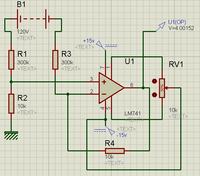love_electronic
Member level 5

I want to monitor the battery voltage( 120v DC) using microcontroller.For that i am using opamp circuit.
I want, when there is 120v DC at battery, the output of the opamp give 4v
for that purpose i use the formula
Vout= -(Rf/Rin) * Vin
4v=-(10k/Rin) * 120
Rin= 300k ohm
i simulate it on the proteus and it shows me the correct result which i desire.
I wanna ask is my calculations are correct or is this the right way to calculate the parameters?

I want, when there is 120v DC at battery, the output of the opamp give 4v
for that purpose i use the formula
Vout= -(Rf/Rin) * Vin
4v=-(10k/Rin) * 120
Rin= 300k ohm
i simulate it on the proteus and it shows me the correct result which i desire.
I wanna ask is my calculations are correct or is this the right way to calculate the parameters?




